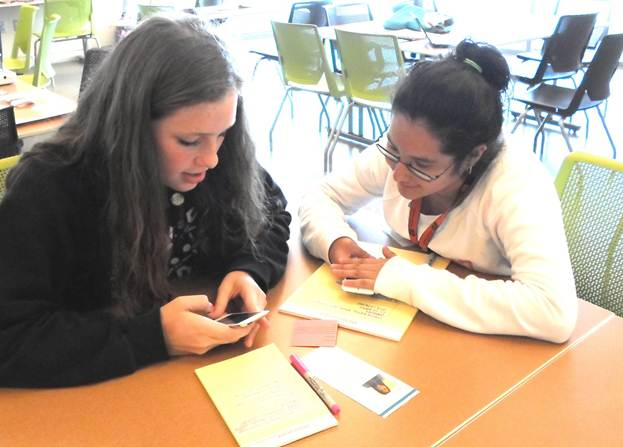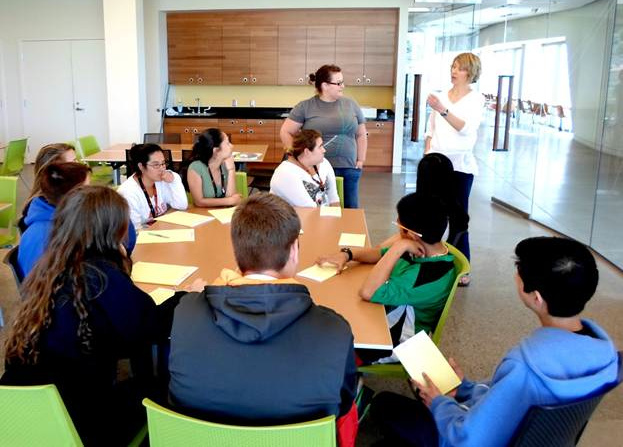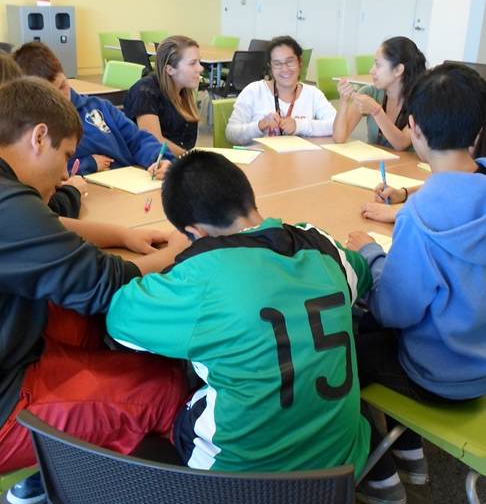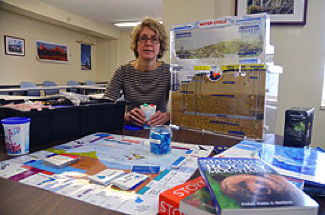Project and Water News
Teens test CI-WATER role play activity
On May 9, teens in the Youth Teaching Youth program at the Natural History Museum of Utah pilot-tested a role playing activity designed to help participants think about water management issues from a variety of perspectives.
Facilitators Heather Paulsen of the Natural History Museum of Utah and Beth Cable of Wyoming EPSCoR, both CI-WATER partner organizations, guided ten high school students through a mock city council meeting on water resource issues. The session began with the teens brainstorming local Salt Lake City water issues, then considering and representing a chosen concern from different assigned perspectives, including farmers, city residents, land developers, utilities managers and more.
Youth Teaching Youth is an innovative program that aims to help students build stronger futures through engaged learning in an informal environment. For more information about this program, click here.



Images: (1) After a group brainstorming session, participants paired up to discuss how their role play persona would think about water resources. (2) CI-WATER’s Beth Cable and the Natural History Museum of Utah’s Heather Paulsen facilitate discussion. (3) Students in the Youth Teaching Youth program.
More Information...April 25, 2013
Public Event: CI-WATER Poster Session
The public is invited to support the next generation of science, engineering, technology and mathematics (STEM) by attending the CI-WATER Student Poster Session at the Natural History Museum of Utah from 5–7 p.m. on Wednesday, May 29. High school and university students from Utah and Wyoming will be presenting their work in water science, computer modeling and related topics.
High school presenters were selected by representatives of the CI-WATER Outreach and Education team at regional high school science and engineering fairs. University students who participated in the multi-campus graduate course, “Hydroinformatics,” have also been invited to present. Senior researchers involved with the CI-WATER project will be on hand to talk with the students.
Communication skills are considered increasingly important to leaders in STEM fields. Through this event, CI-WATER is providing up-and-coming STEM professionals an opportunity to gain valuable experience in sharing their work with the public.

Photo:
CI-WATER Outreach and Education team member Lisa Cohne awarded youth with invitations to participate in the Student Poster Session to be held on May 29.
April 17, 2013
Register for "See the Future of Science"
Join students from Utah Science and Engineering Fairs, University students of Hydroinformatics and Dr. Miriah Meyer for an evening of Visualizing Data at the CI-WATER Symposium.
This event is free but registration is required and seating is limited so register today.
More Information...April 10, 2013
Water science gets hands-on with CI-WATER Teacher Toolboxes

Soon, students, educators and community groups in Utah and Wyoming will have access to the water science resources in the CI-WATER Teaching Toolboxes.
As part of CI-WATER’s commitment to fostering STEM literacy in the community, the Education and Outreach team has created kits designed to foster a better understanding of how the quality and availability of water is affected by climate, population and land use. Educators in Utah and Wyoming can check out the kits which include everything from field measuring equipment for analyzing water quality to a board game to help players better understand water resource management.
“Mostly, we want students to learn that water is a limited resource and understand the effects and impacts of water and water availability in Wyoming and Utah,” says Beth Cable, a member of the CI-WATER Education and Outreach Team and Diversity Project Coordinator for Wyoming’s National Science Foundation EPSCoR Office.
Designed to promote problem solving, creativity, critical thinking and communication skills, the kits are based on four main ideas: the properties of water, water in the environment, human use and impact, and “What do I do now?”
Each CI-WATER Teaching Toolbox includes a plastic, wheeled tub that houses a plethora of field equipment and classroom resources: water quality testing kits, 3-D molecular water kits, petri dishes, various collection jars and vials, a groundwater model, a soil/sediment collector, GPS, a pH kit, a thermometer, various calorimeters for measuring nitrates and phosphates, and other tools. In addition, the toolbox includes the game Hydropoly, supplies, role-playing equipment, a DVD, flashcards, and various field guides and books.
“It’s really good equipment,” Cable says. “The students will be able to measure water quality very accurately.”
Using the toolboxes, students and teachers will be able to examine their personal water use, create water conservation plans for their schools, learn scientific concepts in the classroom and in the field, and create art and advocacy projects in their communities. Students can even perform a role-playing exercise centered on a community water issue. For example, students play different parties—such as ranchers, farmers, business owners, homeowners, environmentalists, etc.—to better understand various issues and concerns.
“Students take a role, and conduct some research on the issue and their position within it,” Cable says. “They then come together for a town meeting and role-play, with the goal of creating a solution that everyone can work with.”
Educators sign up for the kits online and either pick them up or request shipping, depending on location. Four CI-WATER Teaching Toolboxes will be housed at the Natural History Museum of Utah, one will be at the University of Wyoming and another will be at the Science Zone in Casper. Additional kits for Wyoming will be created if funding allows and there is sufficient demand.
For more information or to check out a water science toolbox, visit the CI-WATER Toolbox page.
Photo:
Beth Cable, education, outreach and diversity project coordinator for Wyoming’s National Science Foundation EPSCoR Office, poses with field equipment and materials that make up the water science toolboxes.







